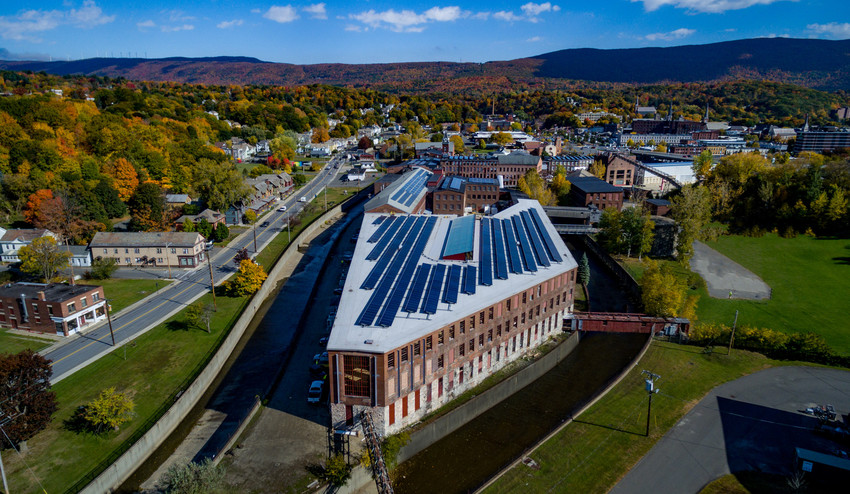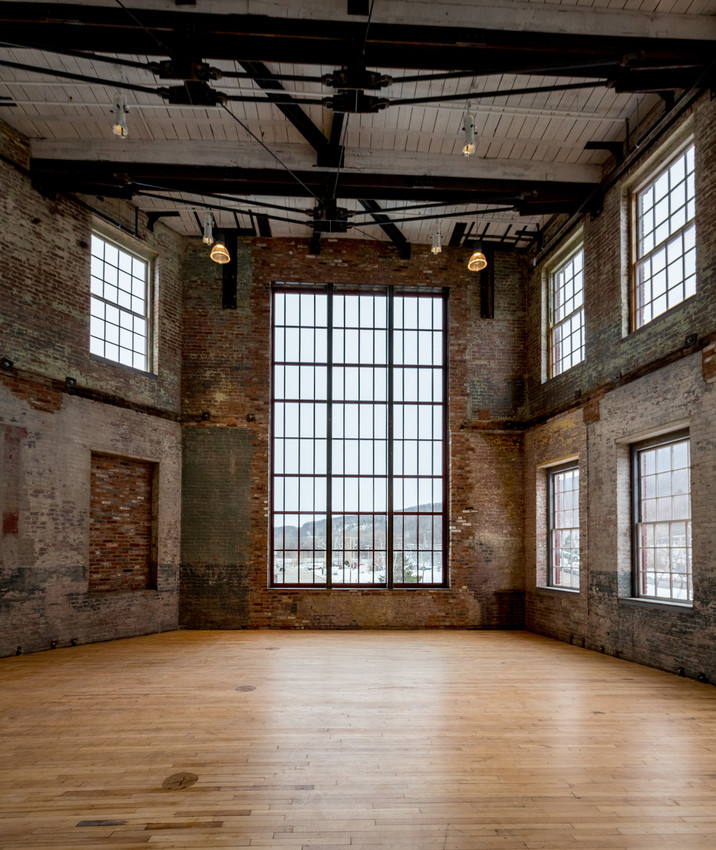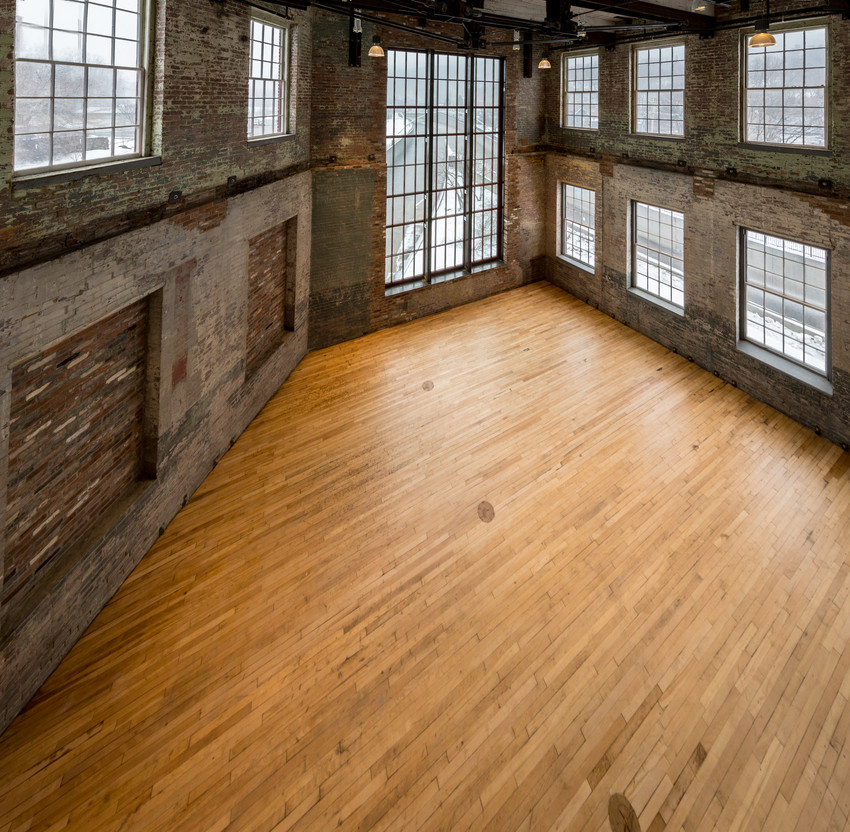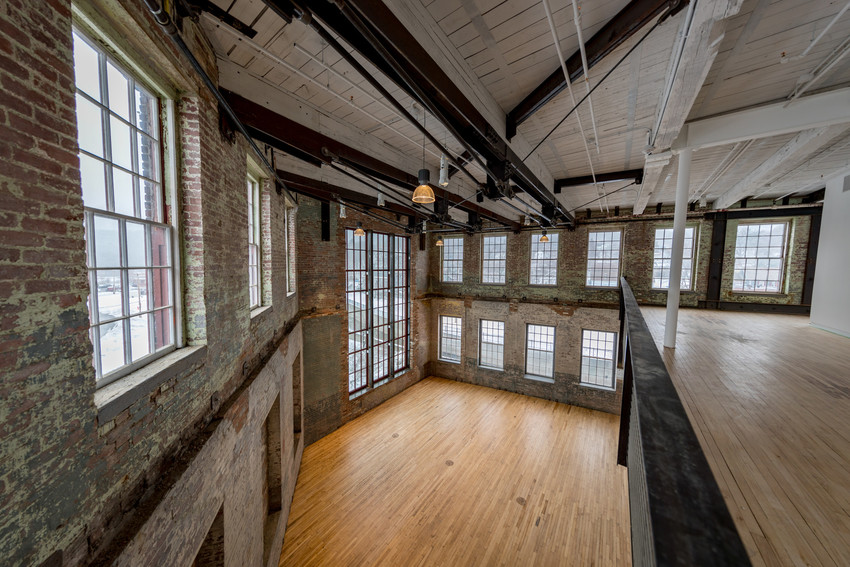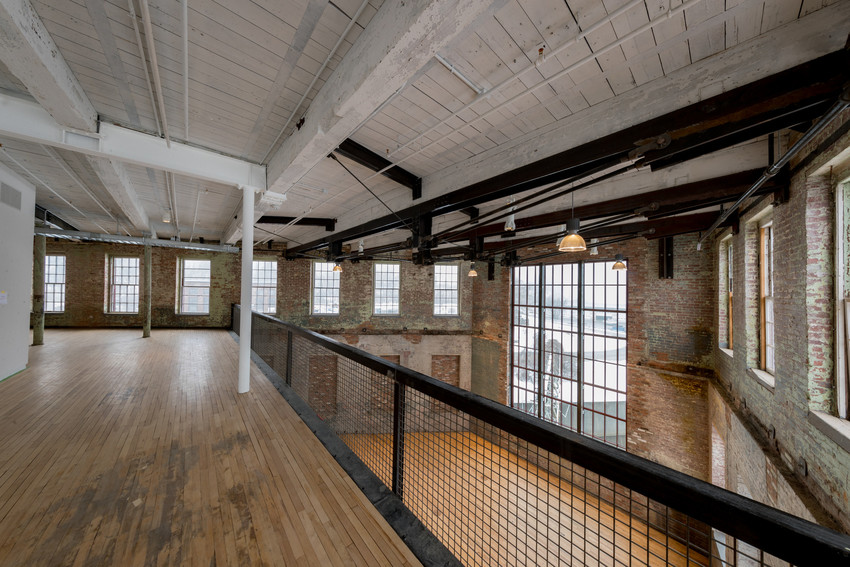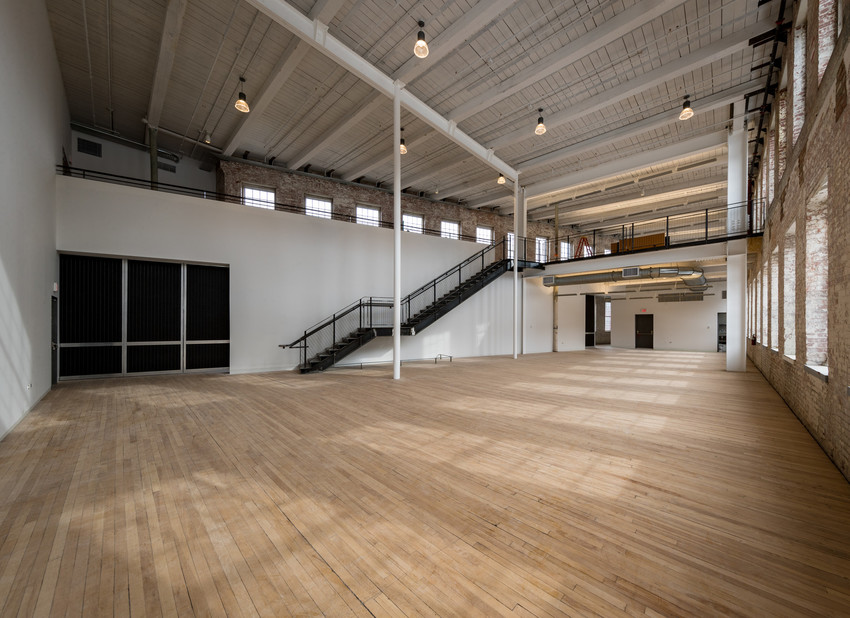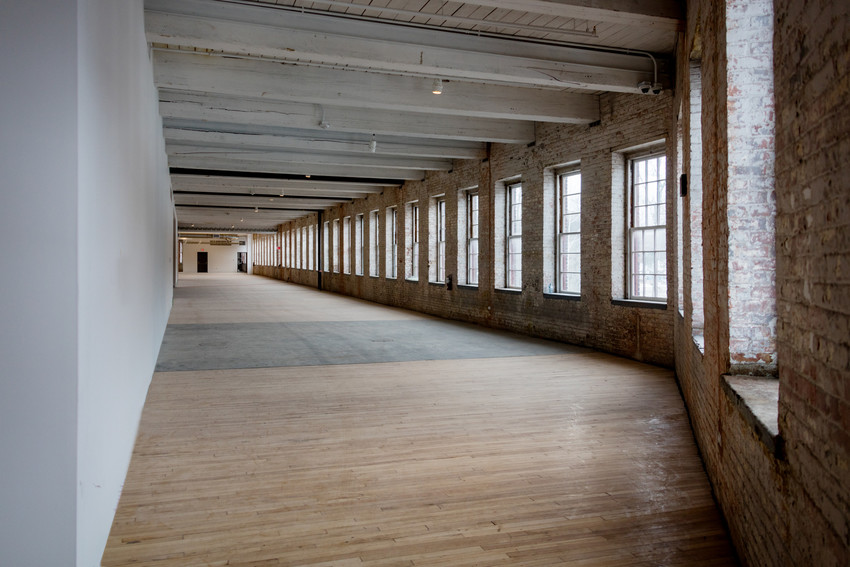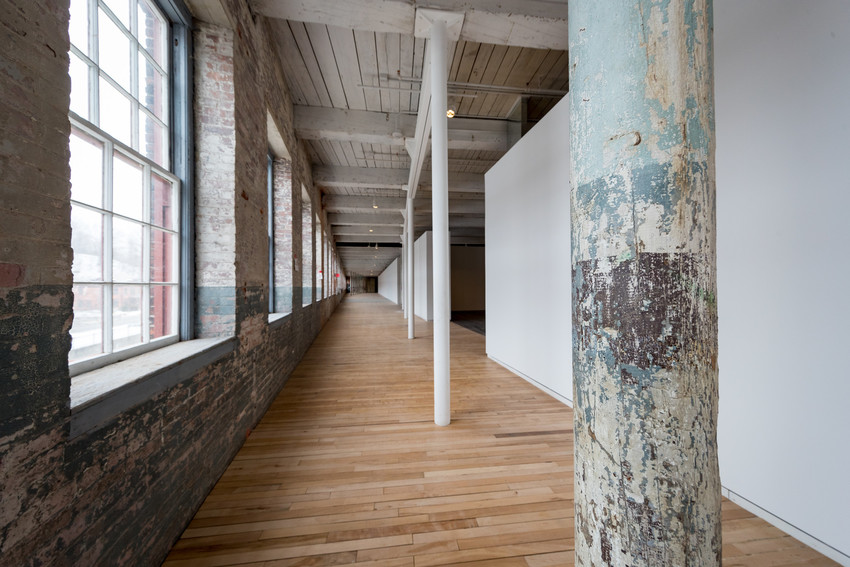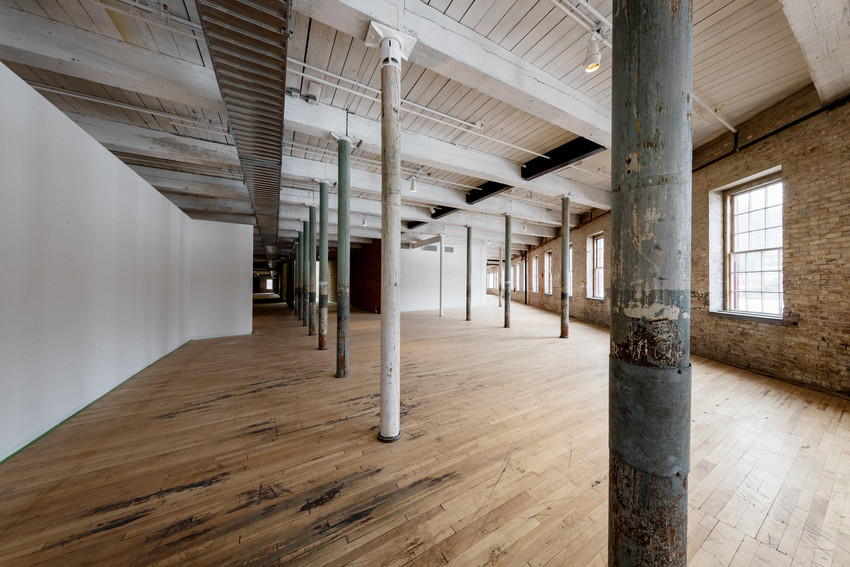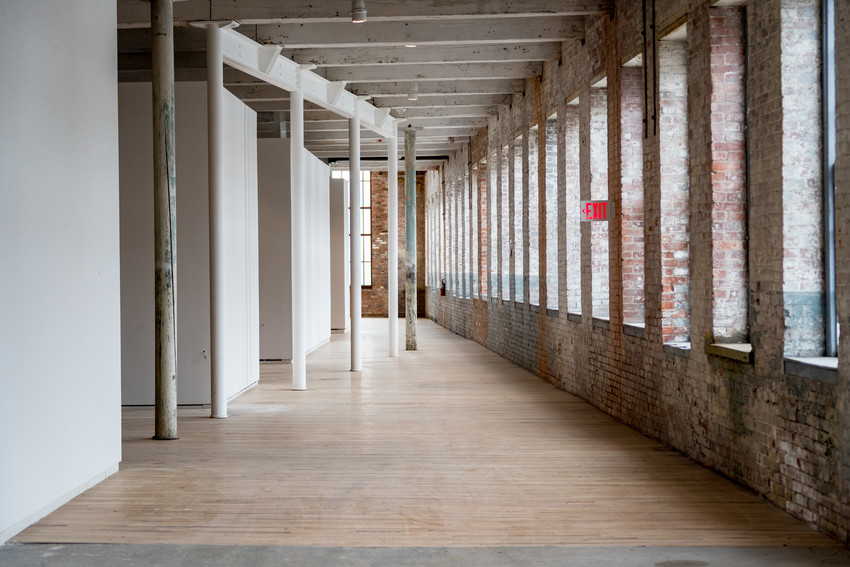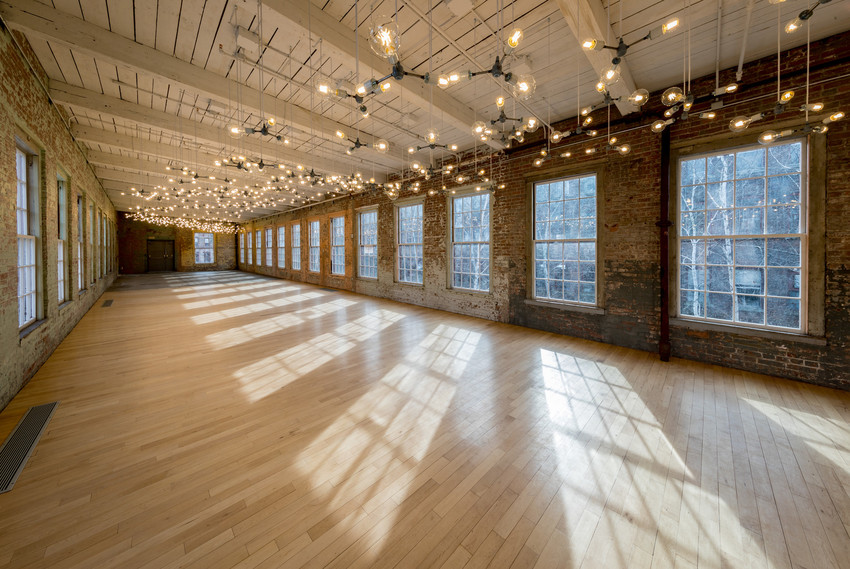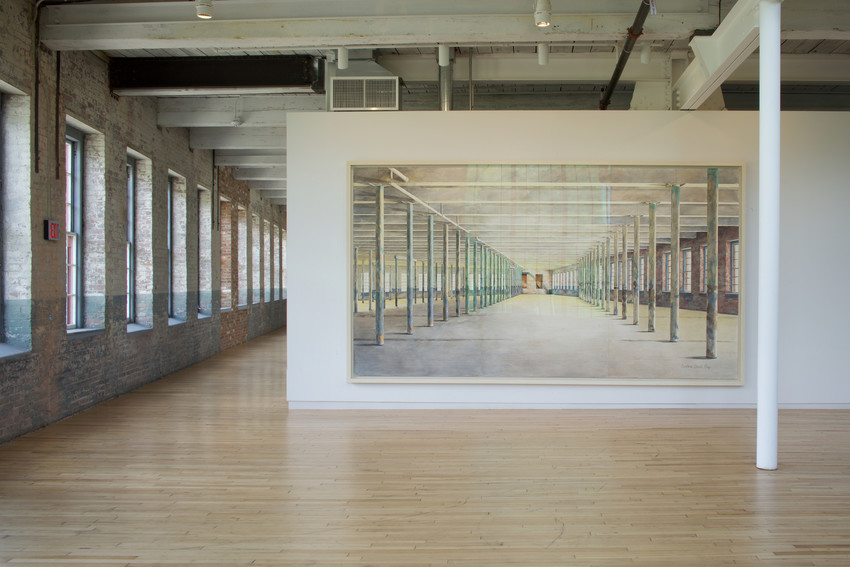MASS MOCA OPENED NEWLY RENOVATED BUILDING 6 ON MAY 28, 2017:
DOUBLING GALLERY FOOTPRINT
ADDING NEW SERVICES AND AMENITIES
FOR PERFORMING ARTISTS AND THEIR AUDIENCES
On May 28, 2017, MASS MoCA opened its newly renovated Building 6, adding 130,000 square feet of space, nearly doubling the institution’s current gallery footprint and adding new art fabrication workshops, performing artists’ support facilities, music festival amenities, and other programmatic capacities.
The centerpiece of Building 6 is a series of changing exhibitions and long-term installations and collaborations with artists Laurie Anderson, Jenny Holzer, James Turrell, the Louise Bourgeois Trust, the Robert Rauschenberg Foundation, and the estate of Gunnar Schonbeck. Additional artists featured include Sarah Crowner, Dawn DeDeaux and Lonnie Holley, Spencer Finch, Janice Kerbel, Sol LeWitt, Mary Lum, Richard Nonas, Optics Division/Metabolic Studio, Barbara Ernst Prey, and Joe Wardwell.

Building 6 sits at the western perimeter of MASS MoCA’s campus, its prow-like triangular footprint shaped by the confluence of the north and south branches of the Hoosic River. Visitors will enter the new space through Building 5, the signature gallery for MASS MoCA’s large-scale installations, or through Building 8, where a light-based work by Spencer Finch has been on view since February 4, 2017.
Building 6, a three-story post-and-beam building, is distinguished by the ample natural light that enters through the hundreds of windows lining the perimeter of the building. Additional natural light filters into the core of the building through a historic lightwell that was restored during this renovation, its roof replaced with a skylight measuring 20’ wide by 140’ long. This rediscovered space incorporates a new series of stairs and bridges that encourage easy movement between floors and across the two sides of the building.

“We love the way the building accommodates a powerful assembly of visual art, but also increases our capacity to host performers and the audiences who patronize our live events,” says MASS MoCA Director Joseph Thompson. “Building 6 encourages patrons to explore our entire 16-acre campus, opening a big, freewheeling, circulation loop, long site lines, and beautiful views onto inner courtyards and the neighborhoods and surrounding hills of North Adams.”
2016: Aerial views of the Massachusetts Museum of Contemporary Art from drone.
~~~~~~~~~~~~~~~~~~~~~~~~~~~~~~~~~~~~~~~~~~~~~~~~~~~~~~~~~~
New construction, Building 6 at Mass MoCA, North Adams, MA.
New construction, Building 6 at Mass MoCA, North Adams, MA.
New construction, Building 6 at Mass MoCA, North Adams, MA.
New construction, Building 6 at Mass MoCA, North Adams, MA.
New construction, Building 6 at Mass MoCA, North Adams, MA.
New construction, Building 6 at Mass MoCA, North Adams, MA.
New construction, Building 6 at Mass MoCA, North Adams, MA.
New construction, Building 6 at Mass MoCA, North Adams, MA.
New construction, Building 6 at Mass MoCA, North Adams, MA.
New construction, Building 6 at Mass MoCA, North Adams, MA.
New construction, Building 6 at Mass MoCA, North Adams, MA.
New construction, Building 6 at Mass MoCA, North Adams, MA.
New construction, Building 6 at Mass MoCA, North Adams, MA.
New construction, Building 6 at Mass MoCA, North Adams, MA.
New construction, Building 6 at Mass MoCA, North Adams, MA.
New construction, Building 6 at Mass MoCA, North Adams, MA.
New construction, Building 6 at Mass MoCA, North Adams, MA.
Barbara Ernst Prey. MASS MoCA Building 6, 2016 – 2017. Watercolor, gouache, and pencil on paper, with materials from Building 6. Courtesy of the artist.
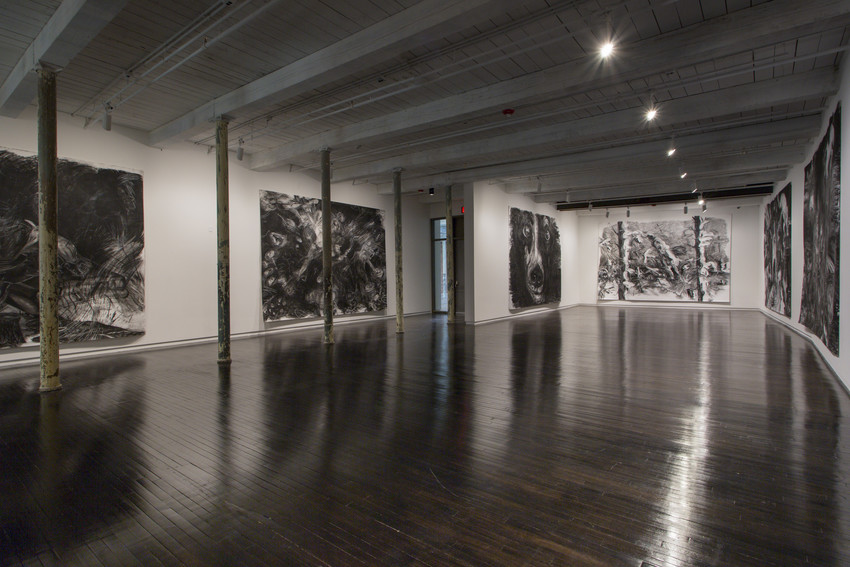
Opening Day / Building 6
~~~~~~~~~~~~~~~~~~~~~~~~~~~~~~~~~~~~~
Long-term Installations with
Laurie Anderson, Louise Bourgeois, Jenny Holzer, Gunnar Schonbeck, and James Turrell,
and Exhibitions with the Robert Rauschenberg Foundation
———————————–
 Once Around, Violet (Shallow Space), 1971 Collection of Tallulah Anderson. © James Turrell, Photo by Florian Holzherr.
Once Around, Violet (Shallow Space), 1971 Collection of Tallulah Anderson. © James Turrell, Photo by Florian Holzherr.
James Turrell
In James Turrell’s hands, light is more than a source of illumination: it is a discrete, physical object. Planes of light seem to float, suspended, in ceilings or walls; architecture disintegrates; brilliant geometric shapes levitate in mid-air. A pioneer in the Southern California Light and Space movement, Turrell began using light as a sculptural medium in 1966, painting the windows of his studio in Santa Monica to seal off the natural light and experimenting with sunlight projected through shades and blinds. MASS MoCA will present a multi-decade retrospective of his work in Building 6 — with galleries designed and constructed by the artist. This exhibition will feature at least one work from each decade of Turrell’s career.
——————————————————————-
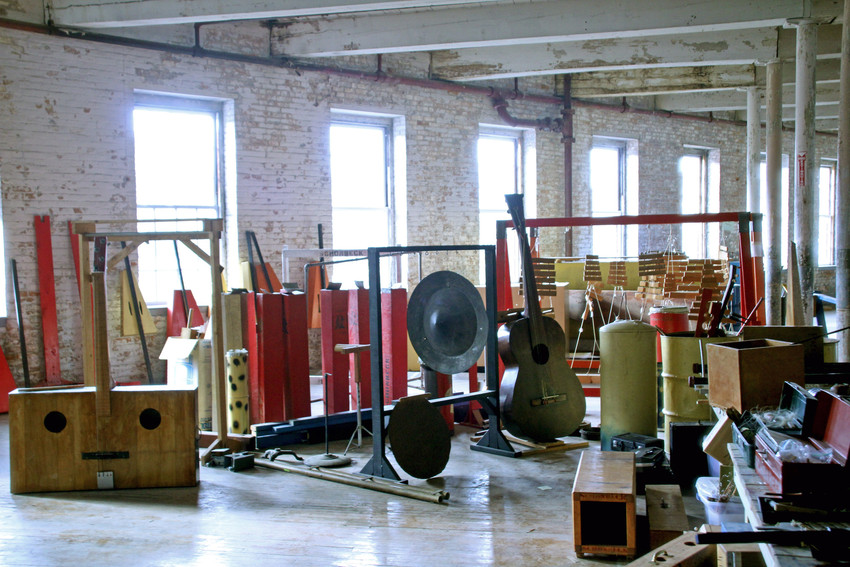 Gunnar Schonbeck Instruments
Gunnar Schonbeck Instruments
Gunnar Schonbeck: No Experience Required
Over a period of fifty years, Gunnar Schonbeck —an ethnomusicologist and composer at nearby Bennington College — amassed an arsenal of hundreds of handmade musical instruments. His works include a 9-foot banjo, an 8-foot tall marimba, drums made from aircraft fuselages, welded steel harps and countless steel drums, zithers, pan pipes, tubular chimes, and triangular cellos. His practice was built around his belief that anyone can be a musician and that every object contained within it an inherent musicality. In 2011, MASS MoCA worked with Bennington College, where Schonbeck taught from 1947-2008, to move Schonbeck’s surviving instruments from the college to the museum. Over the last five years, visiting musicians to MASS MoCA, including Bang on a Can’s Mark Stewart and Wilco’s Glenn Kotche, have drawn on Schonbeck’s instruments in their performances and projects. With this installation — which will look and feel like a high school band room, with Schonbeck’s instruments placed in shelves lining the walls — visitors will be encouraged to play and make music of their own beat.
——————————————————————-
 Jenny Holzer. Xenon for Berlin, 2001. Light projection. Museumshöfe, Berlin. Text: Mother and Child, 1990. © 2001 Jenny Holzer, member Artists Rights Society (ARS), NY. Photo: Attilio Maranzano
Jenny Holzer. Xenon for Berlin, 2001. Light projection. Museumshöfe, Berlin. Text: Mother and Child, 1990. © 2001 Jenny Holzer, member Artists Rights Society (ARS), NY. Photo: Attilio Maranzano
Jenny Holzer
Jenny Holzer’s concise, often enigmatic, writings infiltrate public life and consciousness through everyday objects such as t-shirts, posters, LED signs, and benches, as well as her paintings and sculpture. In her large-scale projections, which have now appeared in over 40 cities in 20 countries, stark block lettering is thrown onto landscapes and architecture, creating a sort of ephemeral graffiti that links her early street-based practice to her long-standing engagement with media, and to tactics common to news and advertising. Following her monumental installation in MASS MoCA’s largest gallery, Building 5, in 2007 — which marked her first indoor projection in the U.S. — Holzer returns with a campus-wide series of work that will include a large-scale outdoor projection on the River Street side of the factory’s complex titled For North Adams, 21 of her celebrated carved stone benches located throughout MASS MoCA’s sprawling campus, an installation of her Inflammatory Essays posters, and rotating exhibitions of her work spanning the breadth of her career. The new building will open with an installation of her paintings based on declassified and sensitive government documents, alongside two of her acclaimed LEDs, stone benches, and works from her Lustmord series.
——————————————————————-
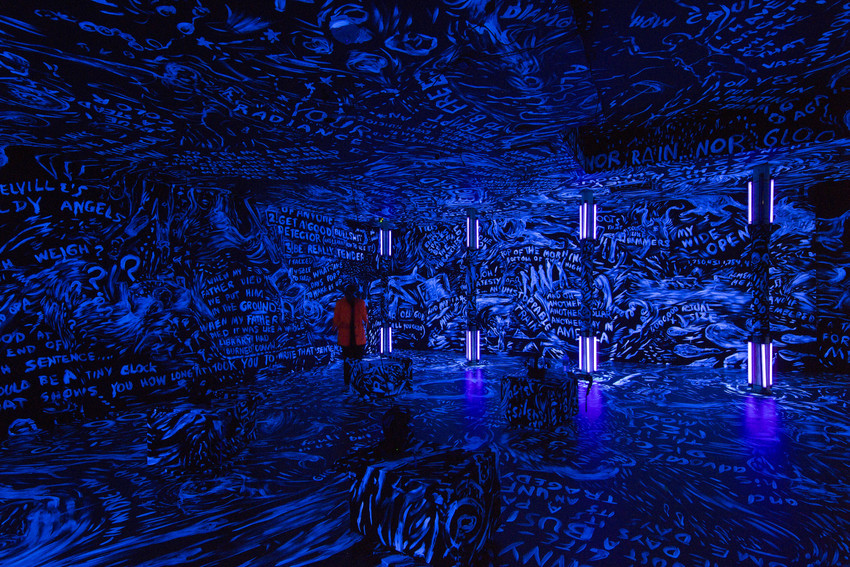
Laurie Anderson, The Chalkroom, 2017. Virtual reality installation with Hsin-Chien Huang.
Laurie Anderson
Laurie Anderson is one of today’s premiere multimedia artists, known for her work as a storyteller, composer, poet, photographer, filmmaker, vocalist, and instrumentalist. Her wide-ranging oeuvre includes the creation of books, albums, and performances that incorporate film, slides, recorded audio, live music, and spoken word, as well as drawings and sculptural installations. Anderson has long been recognized as a groundbreaking leader in the use of technology in the arts, and has developed new musical instruments, including the Tape-Bow Violin, in which the bow has been replaced with magnetic audiotape and the bridge with a reader. She was one of MASS MoCA’s first artists-in-residence, and has returned to the museum many times to develop and discuss works-in-progress. In MASS MoCA’s new Building 6, Anderson will create a multi-functional environment that will serve as a working studio and exhibition venue, highlighting both her creative process and over 10 years of archival work. Included in the opening exhibition is an assembly of her large scale drawings; a re-creation of her historic Handphone Table; a studio dedicated to binaural listening; and two new virtual reality experiences with Hsin-Chien Huang, one of which recreates and enhances a gallery space in which Anderson painted every available surface by hand.
——————————————————————-
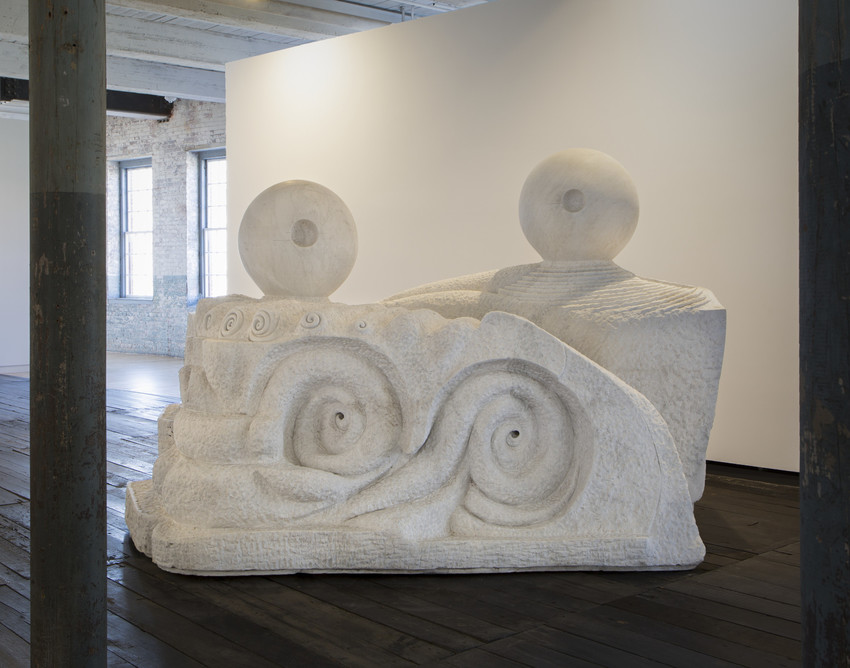 Louise Bourgeois. UNTITLED, 1991-2000. White marble, two elements. 1st: 73 x 74 x 115″; 185 x 188 x 292 cm.. 2nd: 80 3/4 x 43 1/2 x 100″; 205 x 110 x 254 cm. Collection Louise Bourgeois Trust. Photo: Christopher Burke, © The Easton Foundation / Licensed by VAGA, NY.
Louise Bourgeois. UNTITLED, 1991-2000. White marble, two elements. 1st: 73 x 74 x 115″; 185 x 188 x 292 cm.. 2nd: 80 3/4 x 43 1/2 x 100″; 205 x 110 x 254 cm. Collection Louise Bourgeois Trust. Photo: Christopher Burke, © The Easton Foundation / Licensed by VAGA, NY.
Louise Bourgeois
One of the most influential artists of the twentieth century, Louise Bourgeois described her artistic practice as an attempt to work through whatever tumult plagued her — psychologically, personally, or artistically. While her emotional landscape was often her inspiration, her forms take on the landscape of the body, referencing eyes, hands, breasts, testicles, and phalli, which she often merges and blurs together, male and female becoming one. Bourgeois’s diverse practice included drawings, paintings, textiles, embroidered works, sculpture, and installations ranging in scale from a few inches to monumental, fully immersive environments like Untitled (1991-2000), the 15-ton marble sculpture that is the centerpiece of her exhibition at MASS MoCA. MASS MoCA will present three of the artist’s evocative and ambiguous marble sculptures for a period of ten years. As a complement and counterpoint to the weighty works in stone, a cast aluminum work, The Couple(2007-2009), will hang outside the gallery space.
——————————————————————-

©Robert Rauschenberg Foundation
Robert Rauschenberg
Robert Rauschenberg believed that art could foster positive change across diverse cultures. This conviction led him to found ROCI (Rauschenberg Overseas Culture Interchange) and continues to inform the Robert Rauschenberg Foundation’s Captiva Residency program. MASS MoCA’s new collaboration with the Rauschenberg Foundation builds on convictions central to both organizations’ missions: the importance of the relationship between the fine and performing arts, of nurturing new works by established and emerging artists, and of the ability of the arts to affect real change in the world at large. Rauschenberg’s A Quake in Paradise (Labyrinth) from 1994 invites viewers to move through — and become a part of — a maze-like installation of panels printed with the artist’s signature layers of mechanically reproduced imagery. It is shown in tandem with The Lurid Attack of the Monsters from the Postal News Aug 1875, a 1981 cannon-like sculpture from Rauschenberg’s Kabal American Zephyr, which incorporates antique saws and is both threatening and playful.
——————————————————————-
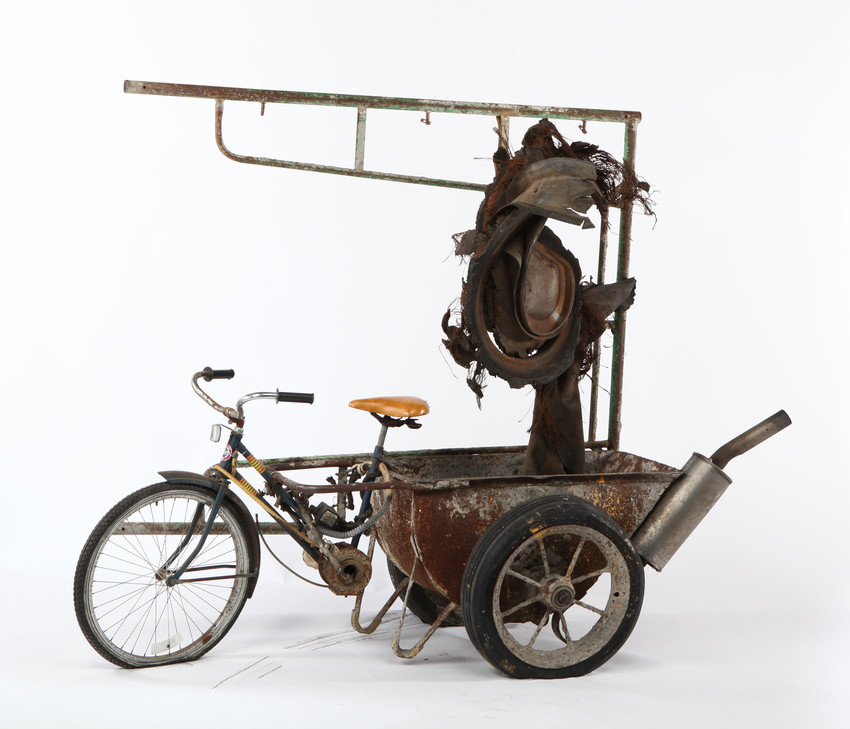 Lonnie Holley (b. 1950). Broken But Still Strong, 2014. 76 x 96 x 39.
Lonnie Holley (b. 1950). Broken But Still Strong, 2014. 76 x 96 x 39.
Dawn DeDeaux and Lonnie Holley: Thumbs Up For the Mothership
An exhibition designed to give an extended public forum to two artists who have participated in the Robert Rauschenberg Foundation Artists-in-Residence program in Captiva, Florida, Thumbs up for the Mothership features works by New Orleans conceptual artist Dawn DeDeaux and Atlanta-based sculptor and musician Lonnie Holley. Deeply influenced by their Southern roots, both artists mine the landscapes around them for found objects (a nod to Rauschenberg’s “combines”) and address issues of ecological and social justice. DeDeaux and Holley believe that through art, they can “help heal the mothership.” Both artists experiment with mixed media and incorporate performance into their practice — ranging from totemic found objects and photography to experimental blues music. Holley states: “There are so many rocks and so many broken stones and so many nails and sticks and weeds and debris and garbage and trash. We have to plow and mine the worst things on this earth to make them better, and to make us better, so we can show the world: I can handle it. I can deal with it. I can live with it. I can go on.”
——————————————————————-
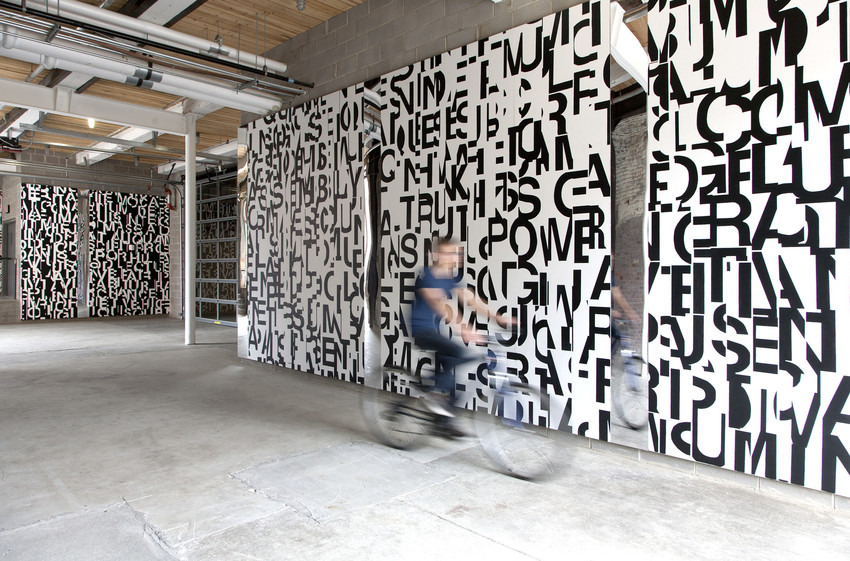
Mary Lum. Assembly (Lorem Ipsum), 2017. Exterior latex, mirror (on four walls). Site-specific dimensions. Courtesy of the artist.
Mary Lum: Assembly (Lorem Ipsum)
Mary Lum, who lives in North Adams, works in a range of media, including wall drawing, painting, collage, photography, and artist books. 20th-century design and typography are important influences, and language plays a central role in her practice. She draws on texts from a diversity of sources, including literature, psychoanalysis, and the news. MASS MoCA commissioned Lum to create a large-scale painting for the bike tunnel that will run through the ground floor of the new museum building. The renovation and restoration of Building 6 includes the creation of a direct link to surrounding bike paths, allowing cyclists to move through campus and engage with outdoor installations without breaking with their routes. Lum’s painting, which spans four walls, is inspired in part by Lorem ipsum, the text that graphic designers and typesetters use as mock content and which was originally drawn from Cicero’s writings on ethics. Embedded in the jumbled text are passages from the First Amendment of the U.S. Constitution, which protects the right to free speech and peaceful assembly. The intricate work moves between writing, image, and pattern, and speaks to the fragmented way in which we acquire information and experience language in today’s world.
——————————————————————-
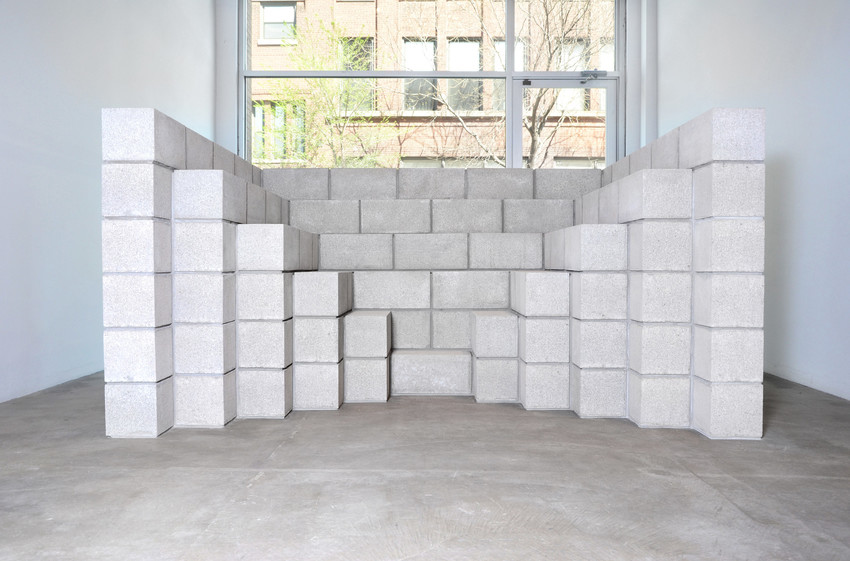 Negative Pyramid, 1997. Concrete blocks. 96 × 79 1/2 × 48 in.
Negative Pyramid, 1997. Concrete blocks. 96 × 79 1/2 × 48 in.
Sol LeWitt: Structures
A new adjunct to MASS MoCA’s long-running Sol LeWitt exhibition A Wall Drawing Retrospective, a concise selection of the artist’s sculptures will be on view in Building 6. Negative Pyramid (1997) and three works from his Incomplete Open Cube series (1974) illustrate in three dimensions the generative potential of LeWitt’s serial approach, exemplified by the museum’s sweeping installation of the artist’s wall drawings — which span LeWitt’s entire career, covering over an acre of wall space on three floors of a building at the very heart of MASS MoCA’s campus.
——————————————————————-
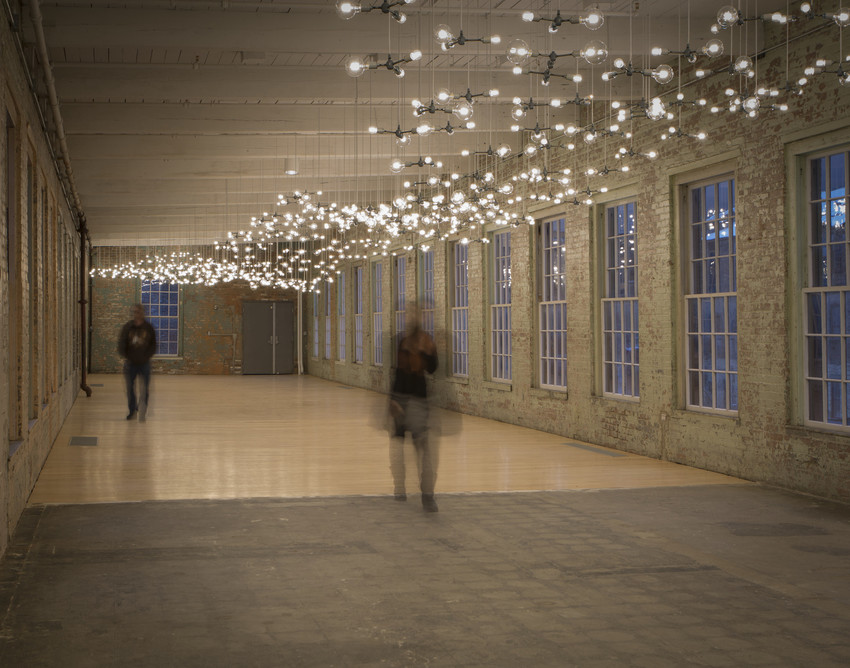 Installation view of: Spencer Finch. Cosmic Latte, 2017. LED light fixtures and lamps. Dimensions variable. Courtesy of the artist. As installed in Building 8, MASS MoCA, North Adams, MA. Photo: David Dashiell.
Installation view of: Spencer Finch. Cosmic Latte, 2017. LED light fixtures and lamps. Dimensions variable. Courtesy of the artist. As installed in Building 8, MASS MoCA, North Adams, MA. Photo: David Dashiell.
Spencer Finch: Cosmic Latte
Spencer Finch, the focus of a major mid-career survey at MASS MoCA in 2007 titled What Time is it on the Sun?, returns to the museum with a long-term installation commissioned and designed in conjunction with the museum’s expansion. Bringing the starry night inside the museum, Finch’s light-based work, Cosmic Latte features over 300 specially fabricated LED fixtures that suspend from the ceiling over an expanse of the 80-foot long gallery. The constellation of LEDs are arranged in the gently arching shape of the Milky Way as it is observed in the Northern Hemisphere in March. The work’s title, Cosmic Latte, refers to the name of the average color of the universe, which in 2009 was determined to be a warmer hue than what has been traditionally thought of as blue. Two American astrophysicists studied the color of the light emitted by 200,000 galaxies and created a cosmic spectrum, which they then averaged according to the light spectrum visible to human eyes. Finch represents that specific warm, yellowish-white shade of light with LED lights (designed to look like incandescent bulbs), which are then arranged in the shape of the molecular model of the pigments needed to create this “cosmic latte” color: titanium white, Mars yellow, chrome yellow, and a touch of cadmium red.
——————————————————————-
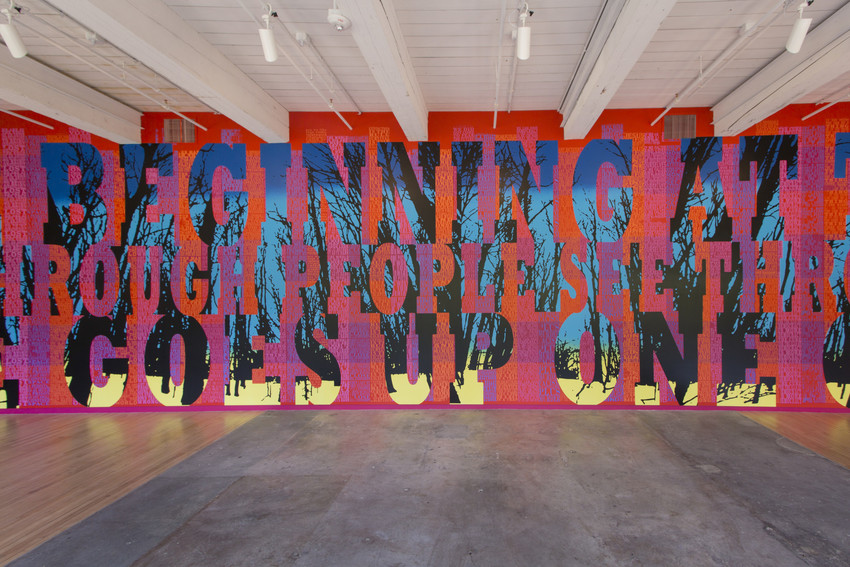
Joe Wardwell: Hello America: 40 Hits from the 50 States
Boston-based artist Joe Wardwell’s Hello America: 40 Hits from the 50 States, a new wall drawing for MASS MoCA, takes inspiration from J.G. Ballard’s 1981 novel Hello America, a book that begins after an energy crisis in the late 20th century leaves America all but abandoned. Wardwell fashions a layered wall work that looks at America through the lens of landscape imagery, political slogans, and song lyrics, beginning with a silhouetted line of bare winter trees taken this winter in the Berkshires. Over this, Wardwell paints a dusky post-apocalyptic landscape of yellows and blues. On top of this are large letters — a slogan camouflaged within the landscape, with lyrics such as punk band Mission of Burma’s “Fame and fortune is a stupid game / Fame and fortune is the game I play” (written by Roger Clark Miller). The final layer is a series of smaller screen-printed texts in repeated vertical bands. These texts are culled from a collection of quotes from various American sources ranging from past presidential campaign slogans, to ruminations on the end of the United States, to the role of government and the rule of law. The lyrics and texts quote works by Jello Biafra, Chuck D, Anne Sexton, Hunter S. Thompson, Abraham Lincoln, William McKinley, Bill Clinton, e.e. cummings, Barack Obama, Henry Rollins, Maya Angelou, and others. In the end, the work is a fragmented portrait in which the larger text, smaller slogans, and landscape function much like the assembled fragments of culture that the explorers in Ballard’s Hello America uncover in their epic journey across the forgotten land.
——————————————————————-
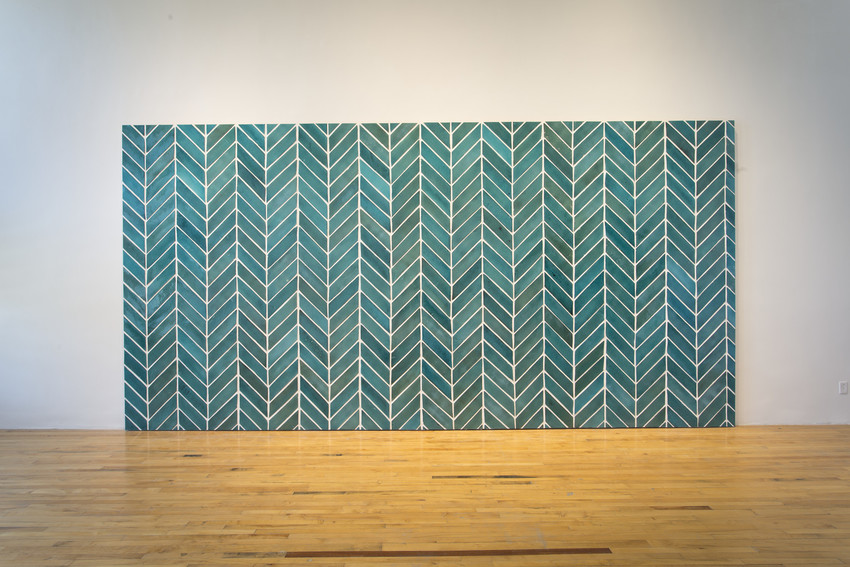 Installation view of Sarah Crowner, Beetle in the Leaves, 2016. Wall (Hot Blue Terracotta), 2014-16. Glazed terra-cotta tiles, plywood, aluminum, mortar, grout. 10 x 20 feet. Courtesy of the artist and Casey Kaplan, New York. Tiles produced with Cerámica Suro, Guadalajara, Mexico. Photo: David Dashiell.
Installation view of Sarah Crowner, Beetle in the Leaves, 2016. Wall (Hot Blue Terracotta), 2014-16. Glazed terra-cotta tiles, plywood, aluminum, mortar, grout. 10 x 20 feet. Courtesy of the artist and Casey Kaplan, New York. Tiles produced with Cerámica Suro, Guadalajara, Mexico. Photo: David Dashiell.
Sarah Crowner: Wall (Hot Blue Terra Cotta)
Sarah Crowner’s gorgeous 10 x 20 foot tile mural Wall (Hot Blue Terra Cotta) (2014-2016) — fabricated for her recent MASS MoCA exhibition Beetle in the Leaves — now guides visitors in and out of the museum’s new gallery spaces, along with a companion work, Tile Painting (Terra Cotta)(2016). Known for her bold and graphic work in a variety of mediums spanning the fine and applied arts, Crowner finds the forms and patterns of abstraction in the everyday. Her elegant structure transforms painting into architecture (and vice versa), with the imperfections and eccentricities of the hand-glazed tiles functioning like a painter’s gestures.
——————————————————————-
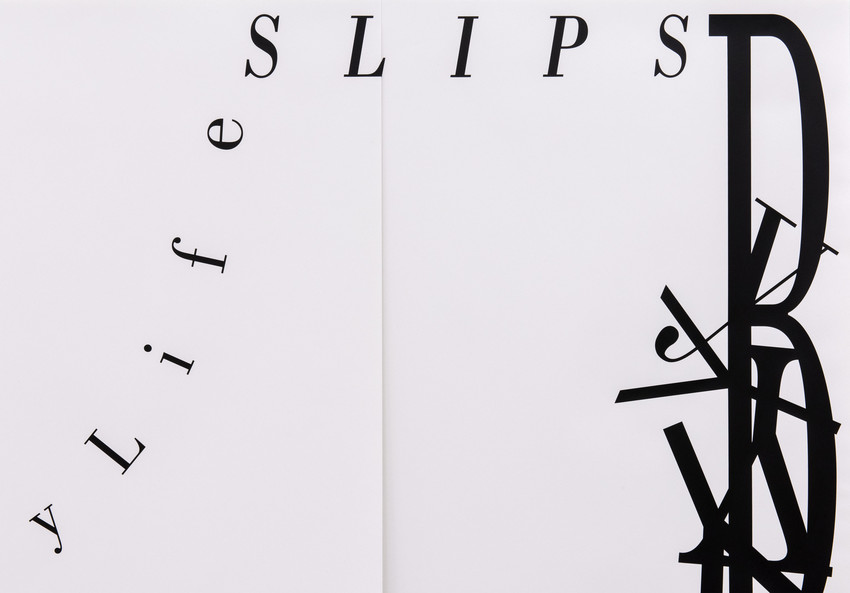 Detail of Janice Kerbel, Score (Slip), 2015. 3 silkscreen prints on paper. Composition: 84 x 194.6 cm (33 â” x 76 â”). Sheets (each): 55.3 x 84 cm (21 ¾” x 33 â”). Photo: SITE photography. Courtesy of Catriona Jeffries, Vancouver; greengrassi, London.
Detail of Janice Kerbel, Score (Slip), 2015. 3 silkscreen prints on paper. Composition: 84 x 194.6 cm (33 â” x 76 â”). Sheets (each): 55.3 x 84 cm (21 ¾” x 33 â”). Photo: SITE photography. Courtesy of Catriona Jeffries, Vancouver; greengrassi, London.
Janice Kerbel: Slip
At once poetic and darkly comedic, Janice Kerbel’s Slip uses graphic musical notation to imagine the trajectory of a body in mortal peril as it slips on a banana peel. Moving from very small to very large print along an upward curve before suddenly crashing downward, Slip unfolds across more than 100 running feet of wall space in Building 6. The work calls on the history of graphic notation, physical comedy, and concrete poetry to create a visual representation of a brief moment across both space and time. Situated just outside of new galleries devoted to the musical instruments of Gunnar Schonbeck and works by experimental musician and artist Laurie Anderson, Slip conflates visual art and musical performance — cornerstones of MASS MoCA’s program — at a grand architectural scale.
——————————————————————-
 Building 6 Panorama.
Building 6 Panorama.
Building Portraits: Optics Division/Metabolic Studio and Barbara Ernst Prey
To celebrate and document Building 6, MASS MoCA commissioned a series of portraits of the building: a watercolor of the building’s interior and two photographs of the building’s exterior. Barbara Ernst Prey painted a large-scale watercolor for MASS MoCA’s expansion, at 9 feet tall by 16 feet wide. Prey’s work depicts the interior and prow of Building 6 just prior to the start of construction. Best known for her plein air paintings, Prey’s commission tackles the vast horizontal spread of Building 6’s second floor, which comprises a full acre of floor area, with some 400 columns, hundreds of windows, and layers and layers of paint. The Optics Division of the Metabolic Studio spent a week at MASS MoCA in fall 2016, using its Liminal Camera, a mobile pinhole camera and darkroom fashioned in a sea container, to create a series of large (over 9 x 4 feet) portraits of Building 6. The artists collected water samples from the Hoosic River, which were then poured over the paper during printing, imbuing the image with ripples of river water. The name “Hoosic” is derived from the Native Algonquian meaning “The Beyond Place.”
 Building 6 Panorama.
Building 6 Panorama.
——————————————————————-
Richard Nonas: Cut Back Through (for Bjorn)
Following his ambitious exhibition in Building 5, The Man in the Empty Space, Richard Nonas created a long-term, outdoor installation in granite for the museum grounds. For five decades, he has made works that alter our sense of landscape and architecture — of place — using the simplest of means. His vocabulary includes pared-down forms and earthy and industrial materials that have a timeless, even totemic quality. Nonas has now reimagined the southeast corner of MASS MoCA’s campus with Cut Back Through (for Bjorn), a new arrangement of the three large granite chairs and five granite stools first seen in MASS MoCA’s galleries. Nonas often changes already-existing works into new combinations, and thus new works. And like Cut Back Through (for Bjorn), many of his works are often arranged in pairs, series, or grids that create a dialogue and tension between the individual elements while creating a new whole from these parts. The grouping of granite sculptures functions as a cut into the landscape, but they also offer museum-goers a place to rest both their bodies and minds.
——————————————————————-
Sponsorship
Major exhibition support is provided by the Horace W. Goldsmith Foundation, the Barr Foundation, and the Massachusetts Cultural Council.
~~~~~~~~~~~~~~~~~~~~~~~~~~~~~~~~~~~~~~~~~~~~~~~~~~~~~
Massachusetts Museum of Contemporary Art
North Adams, Berkshires
www.massmoca.org
——————-
Photos & copy courtesy of MASS MoCA.
——————————————
Visit link for additional information about the renovation:
MASS MoCA: Phase III – Bruner/Cott and Associates, Architects
~~~~~~~~~~~~~~~~~~~~~~~~~~~~~~~~~~~
Visit these AAQ Museum Architecture Portfolios (links)
Glenstone, Potomac, Maryland / 2006 – 2008
Harvard Art Museums, Cambridge / 2014
MAD — Museum of Arts and Design, NYC / 2016
Parrish Art Museum, Water Mill, NY / 2012
The Clark Institute of Art, Berkshires / 2014
The Morgan Library & Museum, NYC / 2006
Wadsworth Atheneum Museum of Art, Hartford / 2017
Whitney Museum of American Art, NYC / 2015
Yale University Art Gallery, New Haven / 2012
________________________________________________________________________-

